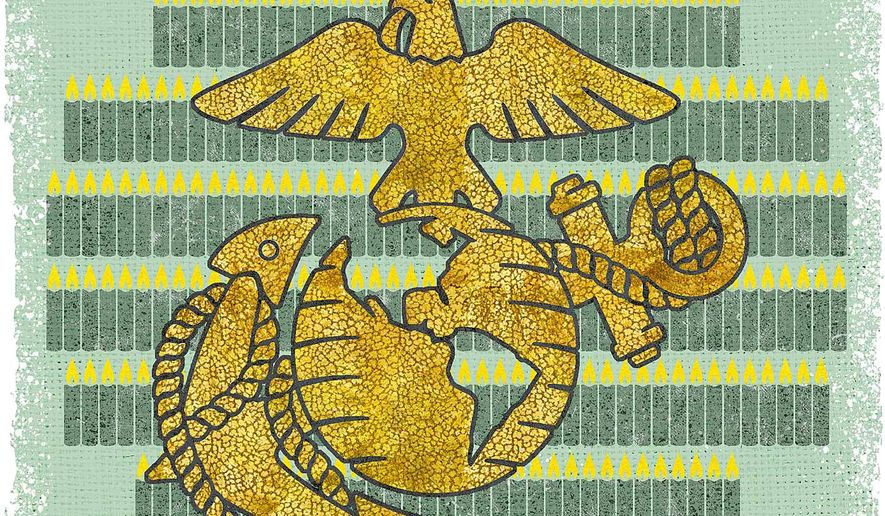OPINION:
Starting an organization in a bar is a risky proposition, and one of two things can happen. First, it might degenerate into a drunken brawl — the alternative is that you will end up with a very interesting organization. In the case of the U.S. Marine Corps, the second happened.
When it began recruiting at Tunn Tavern in Philadelphia following a 1775 act of the Continental Congress, the Marine Corps consisted of a few hundred qualified riflemen designated to act as shipboard policemen, provide the nucleus for boarding parties and provide snipers to fire at the crews of opposing ships. It would have taken a very prescient visionary in 1775 to envision an organization of nearly 200,000 with its own air force. Despite its present size and prestige, the Marine Corps has been on the endangered species list a number of times approaching its 243d birthday on Nov. 10. This year, its existence is not in question, but its core mission may be.
After the Civil War, the age of steam and the development of ironclad warships made close quarters combat and the use of boarding parties obsolete as a naval tactic. Sailors in the Steam Age had to be increasingly professional — thus, the need for ships’ police to put down mutinies was no longer a major problem. This caused some senior naval officers to question the need for Marines. By that time, however, the Corps had developed a sense of self-identity and esprit de corps. Consequently, the Marines found another way to prove themselves useful. The Steam Age required that world-class navies have a series of coaling stations around the world. The seizure and defense of such advanced bases required the use of naval infantry, and the Marine Corps embraced that role. The capture of the Guantanamo Bay naval base in Cuba during the Spanish-American War validated that mission.
During World War I, an unprepared United States desperately needed trained infantry in France. The Marine Corps gladly helped fill that gap, but the nationwide publicity gained by Marines at the Battle of Belleau Wood angered several senior Army officers who began to publicly question whether the nation needed “two land armies” after the war.
The post-Great War Marine Corps was called on to conduct counterinsurgency operations in Central America and the Caribbean, and some senior Marine Corps officers believed that such small wars should be the primary mission of the Corps. However, others saw the coming war with Japan and the need to seize Japanese-controlled islands by amphibious assault as a natural extension of the advanced base mission. Despite this mission argument, successive Marine Corps commandants wisely decided to pursue small wars assignments while simultaneously developing amphibious capabilities. Consequently, the Marine Corps developed the nation’s first official manuals on both counterinsurgency and amphibious operations.
World War II validated the need for amphibious capabilities, and places like Guadalcanal and Iwo Jima became legendary. However, by 1950 the development of atomic weapons was believed to have made ground combat — including amphibious operations — obsolete. Even President Truman held this belief until the Korean War, when a Marine amphibious operation at Inchon proved to be the turning point.
Since Korea, the Marine Corps has maintained its amphibious expertise, but has been careful not to lose its ability to perform in conventional land combat as well as counterinsurgency operations. This determination to “walk and chew gum at the same time” has served the nation well in Vietnam, Desert Storm, Iraq and Afghanistan. Less known have been the countless amphibious rescue operations of American civilians and diplomats from crisis situations ranging from Lebanon to Somalia to Africa.
The ability to make itself useful has ensured the survival of the Marine Corps over the centuries more than anything else. This year, the Senate Armed Services Committee is considering a concept that would have the Marine Corps specialize in small wars — particularly counterinsurgencies and drop the amphibious mission. This concerns many active and retired Marines. The naval threat of China might well require participation in another Pacific naval war and if the nation loses its amphibious capability, it might well have to re-create it.
Marines also worry that turning the Corps into specialists in counterinsurgency might reopen the two land-armies argument. The Marine Corps’ official motto is Semper Fidelis (always faithful), but its unofficial motto has always been “we do windows.” That attitude has served the Corps and its nation well.
• Gary Anderson is a retired Marine Corps colonel. He lectures in Alternative Analysis at the George Washington University’s Elliott School of International Affairs.




Please read our comment policy before commenting.